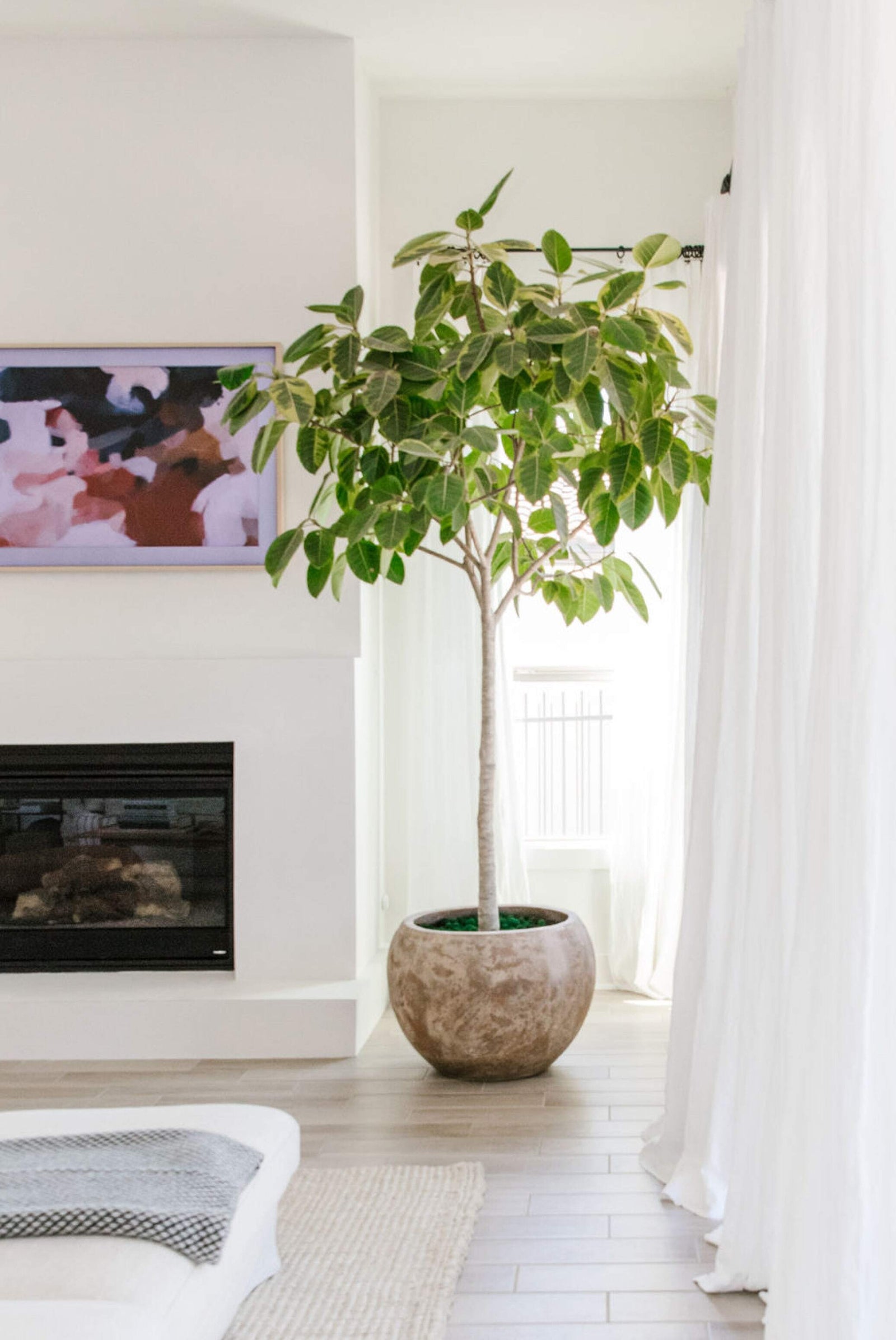The Benefits of House Plants For Cleaner Air And Better Health

When it comes to our survival, experts tell us to remember the rule of 3: you can live about three weeks without food, about three days without water, and about three minutes without air.
We all know it - air is important. Yet, very few of us have been taught how to create and maintain healthy air quality in our own homes.
Equally shocking is that per the EPA, indoor air quality is often 2 to 5 times worse than outdoor air quality and may even be up to 1,000 times more polluted than the outside air.
The air quality of your home is foundational when it comes to staying healthy and preventing disease. The good news is, you have all the power when it comes to creating top-notch air at home.
One of the easiest and most inexpensive ways to do this is to harness the power of air-purifying plants.
Not only have these humble houseplants been proven to help beautify your space and absorb unwanted pollutants, but they also have other hidden benefits for your physical, mental and emotional well-being.
8 Indoor Plants that Clean the Air and Remove Toxins, According to NASA
We all know that plants and trees help clean the air by removing carbon and releasing oxygen into the environment (and to learn more about the far-reaching benefits of this, we highly recommend reading Regenerative Agriculture and What We Learned from Kiss the Ground).
But did you know that common house plants can do the same for indoor air contaminants?
In 1989, NASA conducted a study to determine which house plants were most effective at indoor air pollution abatement.
The study was motivated by NASA’s need to find energy-efficient ways to filter the air at their space stations.
What they found was that many plants are effective at removing the airborne chemicals: benzene, formaldehyde, and trichloroethylene (TCE).
These chemicals are Volatile Organic Chemicals (VOCs), which can be detrimental to your health if inhaled frequently and/or in high concentrations and are a prime cause of “Sick Building Syndrome”.
These plant species have existed long before pollution of any kind, yet they absorb and neutralize these toxins so we can have cleaner air!

Easy-to-Care-For Plants Featured In The NASA Study:
-
Rubber tree (fig or ficus)—these easy-to-find plants are tolerant of sparse watering and do best in medium to high light. Always allow it to dry between waterings.
-
Peace Lily—extremely easy to find and beautiful. They’re low maintenance and require low to medium amounts of both water and sunlight.
-
Snake Plant—can’t keep a plant alive? Have a “black thumb”? This is the plant for you! These low-maintenance plants require sparse watering, thrive on neglect, and will even grow in low light... making them optimal for any space in your home.
-
Spider Plant—these trailing beauties tolerate low light conditions, thrive in hanging pots, and don’t require much water.
-
Money Plant—these are durable, fast-growing, do well with sparse waterings and thrive in medium to high light. They’re great for hanging baskets or pots.
-
Dumb Cane—also known as a mother-in-law plant, this variety likes moderate sunlight and watering.
-
Moth Orchid—water orchids sparingly and be sure the soil drains well. Nourish the soil with a good orchid fertilizer to promote more blooms. To help with the learning curve of caring for orchids, we highly recommend this article from HGTV: 8 Ways to Kill Your Orchid.
-
Philodendron—There are many varieties of philodendrons, most preferring high-light spaces. They’re also very water-efficient, only requiring watering every 10 days or whenever the soil is completely bone dry.
There are more plants listed in the NASA study including succulents, ivies, etc. (which you can review here), but these “top 8” are all easy to find and to care for.
For best results, NASA recommends placing at least two plants every 100 square feet... so that’s about 10-20 plants for your average size home.
*Note for those with furry friends: If you have pets in your household, make sure to double check any plant you plan to bring indoors to ensure it is non-toxic and safe for your pet to be around, in case of contact or ingestion. A quick search on specific plants will identify if it is safe for pets!
In addition to their air purifying qualities, houseplants have also been shown effective at boosting our mental and emotional well-being.

How Houseplants Improve Cognitive Function, Lower Stress and Increase Happiness
We’ve all read stories about how keeping pets can help improve our mental and emotional health and even boost brain power.
As it turns out, plants can have a similar effect, and generally require a bit less work, heartache and investment (though we wouldn’t give up our furry friends for anything!).
According to a new study published Journal of Environmental Psychology 2, keeping plants in your office enhances your ability to maintain attention.
How does this work? Researchers explain that indoor greenery works as a sort of nature therapy, which science has shown to have positive effects on attention.
So the mere presence of natural greenery within an unnatural, computer-driven, LED-lighted environment allows your brain to switch into a more relaxed state, which naturally boosts attention and relieves stress.
Another study by The University of Exeter
In addition, a Harvard University study shows that adding plants to our indoor environments lowers carbon dioxide and boosts oxygen levels in the air.
This improvement in air quality increases cognitive ability, sleep quality, energy levels, and more!
Caring for plants is considered a form of “garden therapy” and has been shown to improve memory and reduce your risk of dementia by 36%
This, along with the benefit of increasing quality of life in seniors
With many of them touting extensive “dementia” gardens to benefit the memory impaired.
As if all this weren’t impressive enough, the simple act of keeping house plants has been shown to reduce depression
Another advantage of plant care - in addition to the benefits from the plants themselves, touching the soil can expose you to beneficial microbes known as outdoorphins that actually help increase happiness and fight depression.
Extra Tip: Keep Your Plants Dust-Free
Dust is one of the leading causes of indoor air pollution because it carries a variety of pollutants including heavy metals, SVOCs and other biological contaminants.
The best defense against this is regular dusting of surfaces, including your plants!
To do so, just wipe gently with Branch Basics Streak Free a couple times a month or whenever you start to see dust build up.
If it feels like a chore, just remember all the health benefits you’re getting by tending to your plants!
Help Us Raise Awareness About the Importance of Indoor Air Quality
As we mentioned in the beginning, the air we breathe is the most essential element to our survival. Yet, few people have been taught about the health impacts of poor indoor air quality or how to create healthier air.
The best way to help us raise awareness is to get educated about common indoor air pollutants, their sources and how to eliminate or reduce them.
We’ve written a variety of articles on this very topic, here are a few to enjoy and share with your friends, family, teachers, bosses, co-workers and anyone who could benefit from better health!
- Better Air Means Better Health: Enhance Your Immunity By Improving Indoor Air Quality
- How to Choose the Best Home Air Purifier
- 2 Things Parents Can Do To Dramatically Improve School Air Quality
Categories

Marilee Nelson
Marilee Nelson is an Environmental Toxins expert who has spent nearly 30 years advocating for the chemically-sensitive and chronically-ill. She is a Board Certified Nutritionist, Certified Bau-Biologist and Bau-Biology Inspector and specializes in Food As Medicine. She has helped thousands of families and individuals identify, heal and recover from toxic exposures and is on a mission to revolutionize the way American families view their health.







